What Type of Cookware Should I Buy?
When I first started cooking on my own I had a nice, ahem, variety (read: horribly mismatched m©nage) of pans in my kitchen. I didn’t know what most of them were– they had come to live with me from a variety of places– from castoff partial sets that others were purging, to flea markets, to yard sales. I had learned how to cook from my Mom, but cooking was not yet a hobby or a passion of mine. I cooked to survive at that time– as long as I had a vessel to cook something in, then I didn’t really care what it looked like. I certainly didn’t know anything about the different kinds of cookware out there. I had something that worked, and that was good enough.
As time passed, my interests started to shift. I was a high school teacher who made almost no money, so often the only “fun” I could afford was creating something at home. I started trying new recipes and experimenting with unique new ingredients that I found locally at the farmer’s market– it was an inexpensive hobby, and I had fun seeing what I could create. In time I started getting better at this cooking thing and truly enjoying it, and as that started to happen I started to itch for new, better quality cookware.
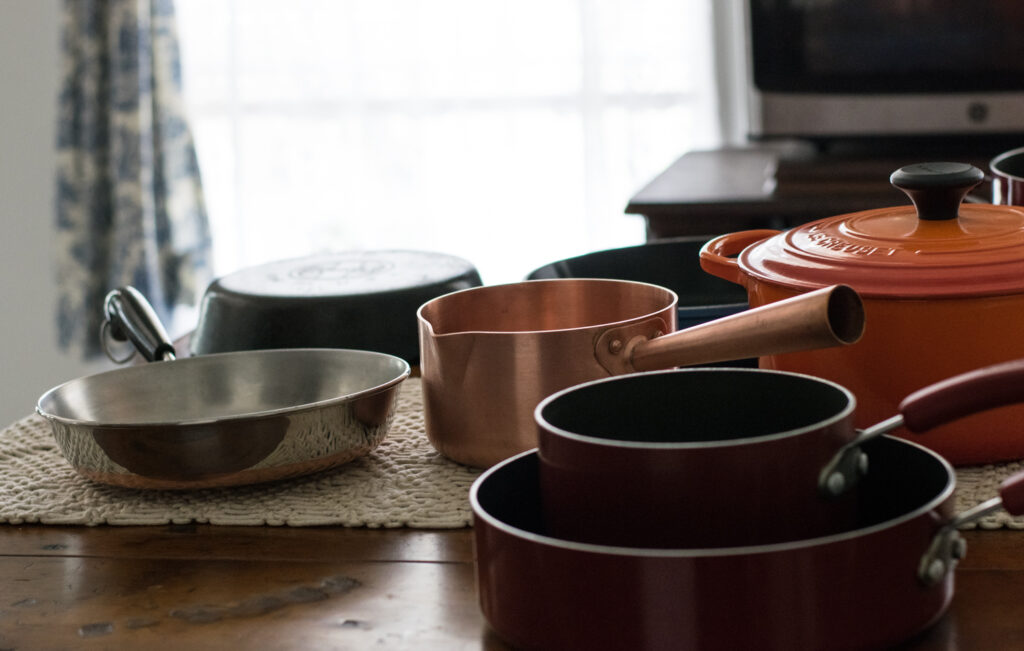
If you have cookware that looks like it belongs to a beat up frat house, then it might be time to upgrade. You will probably find yourself where I did– in the store, baffled at all the sizes, types, finishes, and astounding price differences in cookware. What the heck is a green pan? Is copper worth the money? Why don’t I see nonstick cookware in a professional kitchen– and more important– will a nonstick pan give me CANCER??? Why does everyone say that cast iron is so good, and why can’t I WASH it??? Is my whole life a lie?????
Take a breath. Realize that the best kind of cookware out there is the type that you like and use best. Yes. If you find that a $15 nonstick skillet works better for you than a high end, $1,200 silver-lined Duparquet skillet, then that’s the best choice for you, period. It’s your kitchen and your rules. You don’t have to suffer through cookware that you hate just because some “professional” uses or recommends it. Use what works best for you, in your kitchen, with the way you cook.
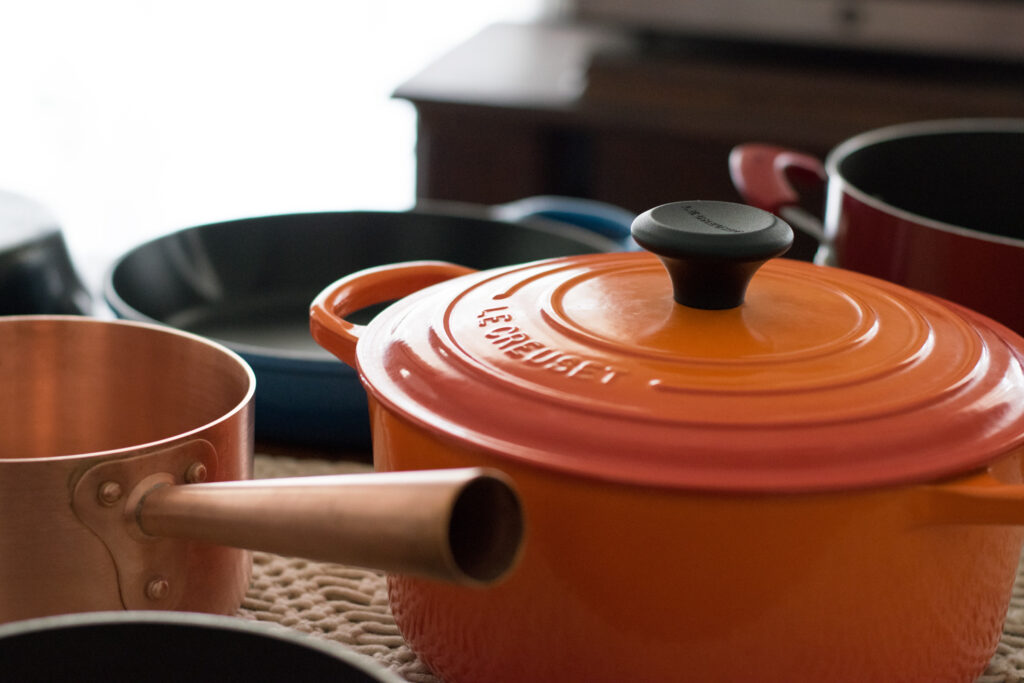
You don’t have to spend a fortune to make a delicious meal, either– I cooked for many years on crappy secondhand pans, and I made some gorgeous, delicious meals on those beloved, battered beasts. However, there comes a time when you need to upgrade– maybe because your pans are falling apart (mine literally fell apart– the handle of one of them was constantly coming off in my hand while I was using it, begging me to give him his pink slip and send him home to blissful retirement), or maybe the coating is starting to flake off. Maybe you just want something beautiful (and matching!) to look at, to inspire you to love cooking again. Maybe for once you’d like to have something that isn’t a hand me down. All of these reasons are valid, and the great thing is that you don’t have to explain your reasoning to anyone– you’re the queen of your own kitchen, and what you say goes.
Whatever the reason you’re upgrading, it helps you to make an educated choice when you know what types of cookware are out there. There is no “one size fits all” to cookware, which is why there are so many different kinds. Cookware types are like cars– there are many brands, varieties, and types, and we each have our favorites for different reasons. A person who cooks the occasional omelette or veggie scramble will have different cookware needs than someone who spends hours in the kitchen crafting the perfect savory beef short ribs with garlic and red wine and deglazing the pan for gravy. Your cooking needs determine your cookware preference, as each type of cookware was developed to meet a different need.
Over the years I have tried many different types of cookware, and I have developed my own personal favorites based on my own personal cooking needs. I have multiple complete sets of various types, which I have supplemented with specialty pans from other lines, to complement my cooking style best. Create the army to fight the way you want it. They are your servants, and you are the queen. Command them as you will! 🙂
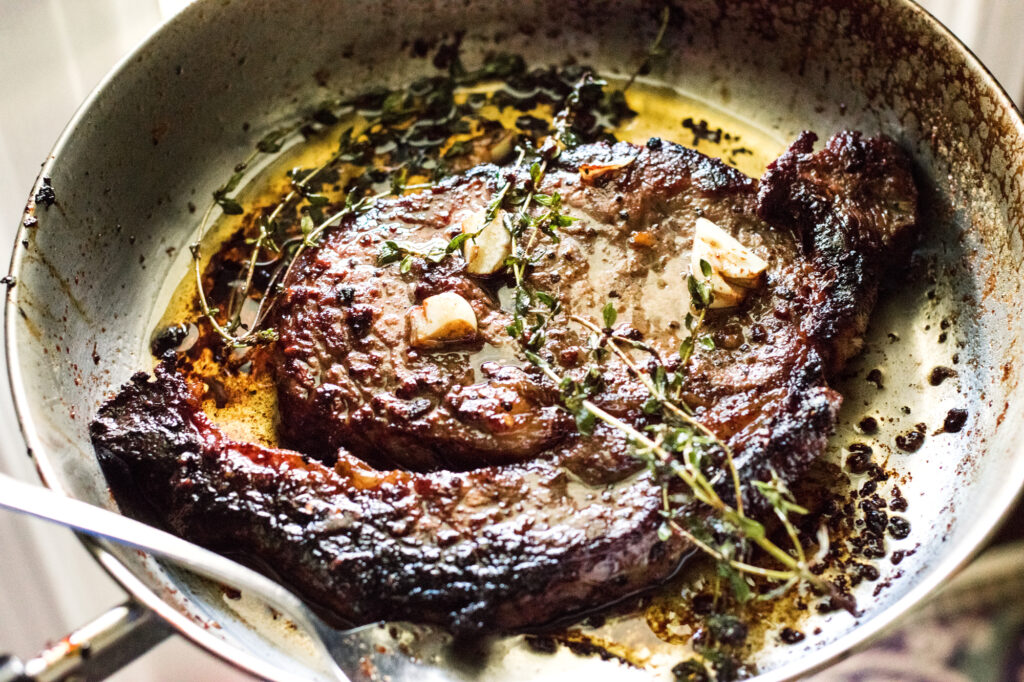
The best way to understand what cookware to get is to determine how you cook most frequently, and therefore, what you need your cookware to do. Instead of telling you “this is the BEST cookware!” I thought it would be helpful to show you what each piece does, and then you can choose which one would most likely meet your cooking style and needs. So let’s take a look at these bad boys and see which one you’re going to take home tonight. 😉

Nonstick
Let’s start out with the set that most cooks start out with– the humble, modestly priced, “you can find one in almost every kitchen on the planet” pan– the nonstick. Nonstick pans are popular for multiple reasons, not the least of which is that they are, ahem, obviously, nonstick. You can cook an egg on these guys and it slips right out. You can caramelize onions and then wipe it clean. You can make pancakes that slip off like a dream. They are fairly inexpensive and come in tons of fun colors. They are also lightweight, easy to wash, and dishwasher safe (supposedly). What’s not to love about that?
Nonstick cookware comes in several varieties, and of course, at a variety of price points and quality levels. My first nonstick pan was an old T-fal skillet that I named Napoleon because he was once so great and had fallen (ohhhh so badly) from grace. I got him at a yard sale (for 25 cents I believe), and he was so badly warped and bent that I had to store him on his side in the cupboard, because he was too oval (some would say too Fabulously French) to mingle with the other pans. That beast was blackened from years of baked on cooking oil (I am not sure the color of the original set was actually black but Napoleon certainly was– oui! oiu!), more crooked than a politician, and so damaged that the nonstick teflon coating was constantly bubbling and flaking off. Eh, it never killed me. But flaking cookware is a definite concern, and obviously you don’t want to be serving “pepper flakes” in food that you haven’t actually seasoned with pepper. It’s bad for friendships to tell your neighbor that she has a piece of your beat up nonstick pan in her teeth. Would she like to floss? You’ll wait.
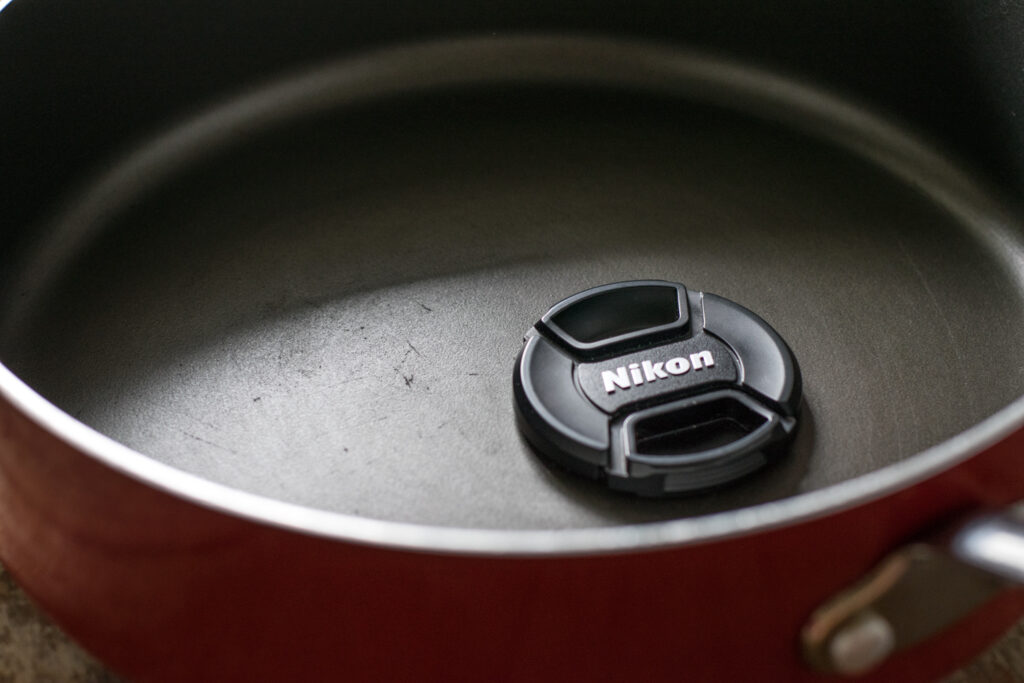
Teflon cookware gets a really bad rap. Everyone hears nonstick and immediately thinks CANCER!!! It will give me CANCER!!!! Well, actually this is only partly true. (So I’ll only PARTIALLY die of cancer? *tears of hope well up in eyes*).
Teflon products used to contain a carcinogenic chemical called PFOA (the bad one that everyone is afraid of). There’s no way around it– they did contain this. Ouch. I think my beat up Napoleon skillet probably contained this chemical (*Taps plays softly in background*). However, due to obvious health concerns, PFOA has now been banned in the production of Teflon cookware (starting in 2013). Skillets produced after 2015 are certified free of PFOA. So my beat up T-fal beast was probably the bad, cancer-causing kind. But Teflon-coated pans produced today don’t have the bad chemical in them. Are they still made out of plastics and non-natural ingredients? Yeah. Then again, do you go to McDonald’s? Your health risk when you go to McDonald’s and use plastic silverware is greater than when you use modern Teflon cookware. It’s not the scary “cancer causing” stuff it once was.
Another big question that people worry about– does Teflon coating still flake off the pan? Yes, nonstick coatings of any kind will still flake under certain conditions (too high of heat, using abrasives (like brillo pads) or metal utensils, being generally rough with them), but nowadays all you have to worry about is the fake pepper in your food and no cancer. I know. It’s not perfect. But ideally if you keep your nonstick pans in good shape they should last several years before the coating starts to break down, and that’s a small price to pay for a perfect egg that slips right out onto your avocado toast without hanging onto the pan like grandma giving the grandkids “just one more hug.” Technically you should throw out a pan when it starts to flake, cancerous or not. Then again, technically you should exercise every day and never eat sugar too– but we don’t always do that. We do the best we can with what we’ve got. For me, personally, I can’t do without at least one nonstick skillet in my kitchen.
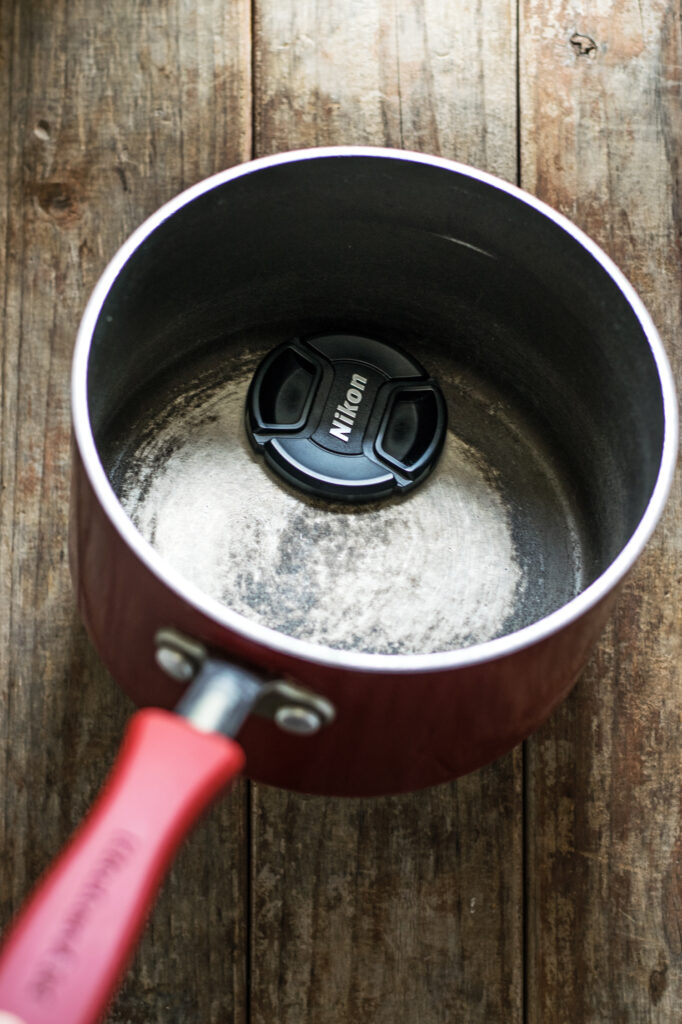
(If you’re wondering why the heck my camera lens cap is basting in these pans, it’s because I needed a focus point on the surface of the finish to show you any nicks or dings, and the camera cap just happened to be close, so it was drafted into service).
The first picture is a nonstick pan that I haven’t used much (a few dings but not bad). The second is one that has been, ahem . . . well loved. I probably should have thrown this pan away, but at this point it has lost so much of its coating that I figure it can’t lose anymore, so I’ve kept it. I have used this pan a lot (obviously), but I’m showing you so that you can see what eventually happens to nonstick cookware– it loses that magic surface and you are left with a very lightweight pan that needs cooking spray to be nonstick. It took me probably 1-2 years to get to this point, but I use metal utensils freely in this one (got it before I knew not to), and that’s part of the reason it broke down more quickly than if you are careful. The disintegrating surface is also why most restaurant kitchens don’t use nonstick– with the amount of food that they prepare, restaurants would be replacing nonstick cookware every other day– so nonstick is just not practical for commercial cooking.
Bottom line: Teflon cookware used to be unsafe. Now manufacturers are regulated and have taken the bad chemical out. Teflon is still prone to flaking if you use super high temperatures or metal utensils while cooking. Flaking pans should be thrown out, cancerous chemicals or not. Nonstick cookware also has a shorter life span (generally 1-3 years) than almost any other kind of cookware (even if you are super careful and follow all the rules), but it balances these negatives by being some of the cheapest and easiest to use cookware on the market. In my opinion, all kitchens need at least one nonstick skillet– just don’t draft my friend Napoleon. He’s a lousy teammate.
If Nonstick were a car, it would be your parents’ 10 year old Honda Civic– a great starter car that will get you from A to B when you’re just starting out, not break the bank, and will probably need to be replaced or upgraded before too long.
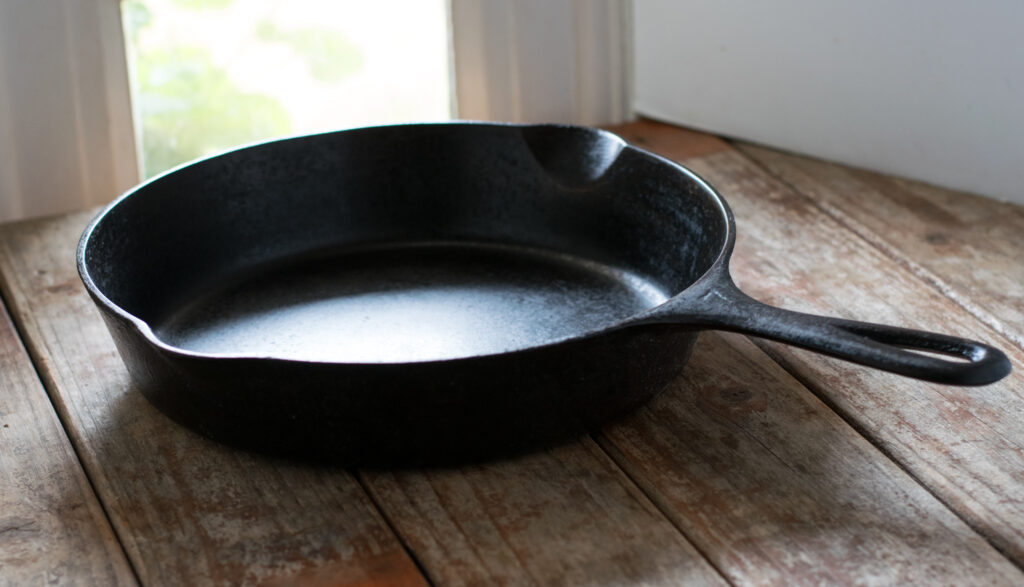
Cast Iron
Another big (if not the biggest) name in the cookware game is cast iron. The values of cast iron are proclaimed far and wide from the rooftops of every cooking magazine and show on the planet, it seems like. The range of these pans are astounding. The price ranges are even more astounding. We will cover the cast iron basics today, and I will include links for further reading if you need more information.
Basic black (usually Lodge brand) is what most people think of when they hear the term “cast iron.” Lodge is a good starter brand. It runs about 20 bucks for a skillet and comes “pre-seasoned,” which actually just means that the factory has sprayed on a kind of black, textured coating to keep it from rusting. “Seasoning” is not actually a spice, even though it sounds like it, but layers upon layers of cooked on grease that eventually become hard, black, and nonstick. This is why most people don’t use soap on their cast iron pans– they don’t want to wash the accumulated grease off, but keep adding layers and layers of it each time they cook. Most cast iron pans are wiped out with a paper towel after cooking– possibly rinsed with plain water, but not actually cleaned with soap– just kind of rinsed for the next use. They are not dishwasher safe (dishwasher will cause them to rust almost immediately).
There are other kinds of cast iron skillets, of course (I am using a vintage Erie, Pennsylvania-made Griswold for this demo). So why is cast iron cookware so valued by the cooking community? Well, to start with, it basically lasts forever. I’m serious. The black skillet in the picture above used to look like this (see gross photo, below. That’s the same skillet on the bottom, believe it or not, before I stripped and seasoned it). This cookware can almost always be revived and made like new. Unlike other kinds of cookware, you can definitely bring rusty old pieces of junk back to life (see the tutorial of how to do that here).
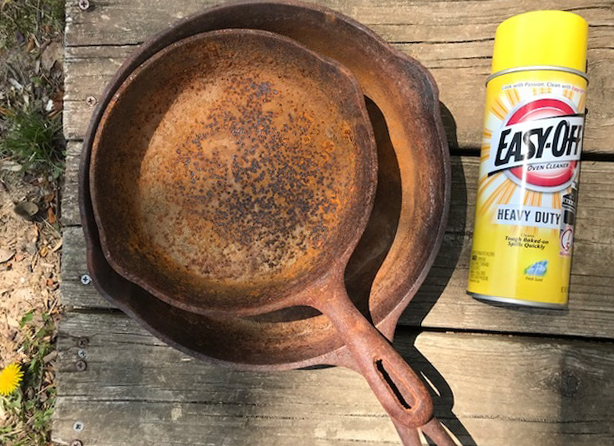
I stripped it down, reseasoned it, and now it’s good as new again, despite being almost 100 years old (!!!). That’s amazing. You can bring this cookware back from the brink of death and have it humming on your stove in no time, every time, as good as the day it was made a century ago. How cool is that, seriously.
Classic cast iron acquires layers upon layers of cooked on grease as you cook, and the neat part is that the grease from your food actually starts to develop a singular “taste” specific to you, in your specific skillet. This means that if you cook with your grandma’s skillet that she’s been making food in for 60 years, that skillet will produce food that is unique in taste to her kitchen, alone, on this planet, because it tastes like all those built up years of cooking that she did using it. Bizarre, right?
One lady told me that after her mother died, she could never get pancakes to “taste the way that mom made them.” Eventually she dug through her mom’s cookware and tried her mom’s cast iron pancake skillet to make them. Upon tasting them she started crying immediately, because the pancakes tasted just like her mom used to make them– that distinct taste that only mom could make. The secret was that the skillet had been seasoned by her mom for decades and retained that same flavor profile each time, because a little bit of that seasoning was, well, seasoning the food it cooked. So using Mom’s old cast iron skillet was, truly, “making it like mom used to make.” Living history like that intrigues me. If you buy an old black skillet at a flea market, you should try cooking on it and taste the flavor of what someone has been cooking for maybe even longer than you’ve been alive. It’s kind of gross, kind of strange, and very cool.
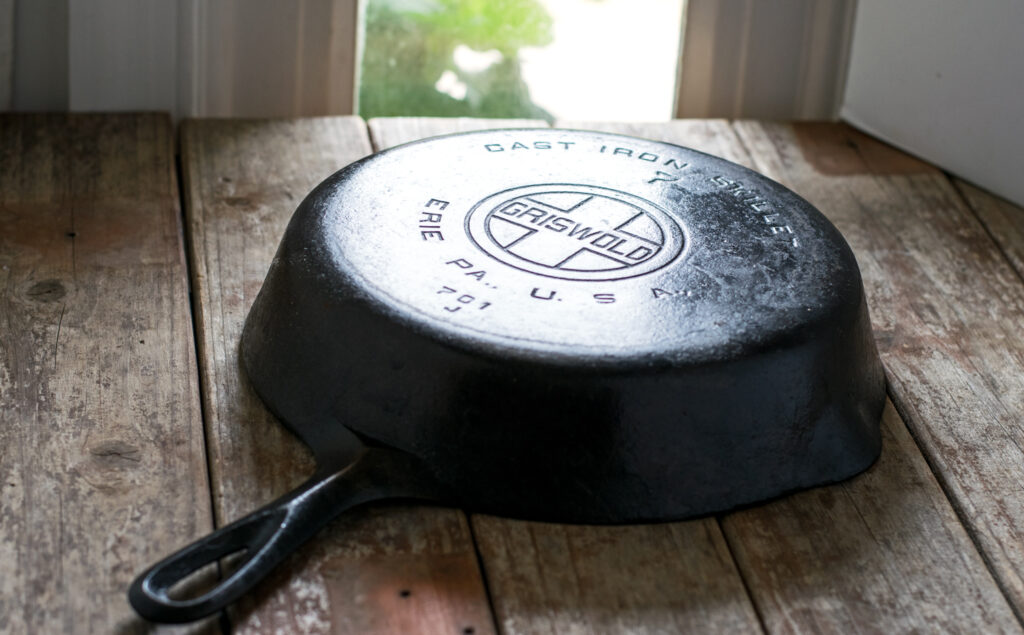
Cast iron skillets take a long time to get hot– I generally put them on the stove to start heating 10-15 minutes before I’m ready to cook, because it takes them that long to heat up. They also take a long time to cool down, which makes them great for keeping leftovers warm. I can cook dinner, shut off the heat, and leave my food in the skillet to serve. The food stays piping hot the whole meal. Many people new to cast iron make the mistake of saying “Oh my pan is not getting hot– I better turn up the HEAT!” because their pan isn’t instantly hot, like a nonstick pan is. Give it time. Cast iron takes a good 10 minutes to heat up. Leave the heat constant and don’t rush it.
That “heat holding” quality is one of the main reasons that people love cast iron for cooking. You can fry chicken in a cast iron pan and the pan will keep the heat constant. If you try to fry something in a nonstick pan the aluminum will lose its heat so quickly that when you drop cold chicken into the hot oil, the oil temperature will drop so much that the chicken becomes congealed and soggy– not crisp. A cast iron pan holds right onto that heat and keeps the oil hot enough that the chicken becomes deliciously crispy and golden brown. Cast iron pans do the same to steaks– they provide a fabulous sear without losing their temperature (and steaming the meat by accident with too low of heat).
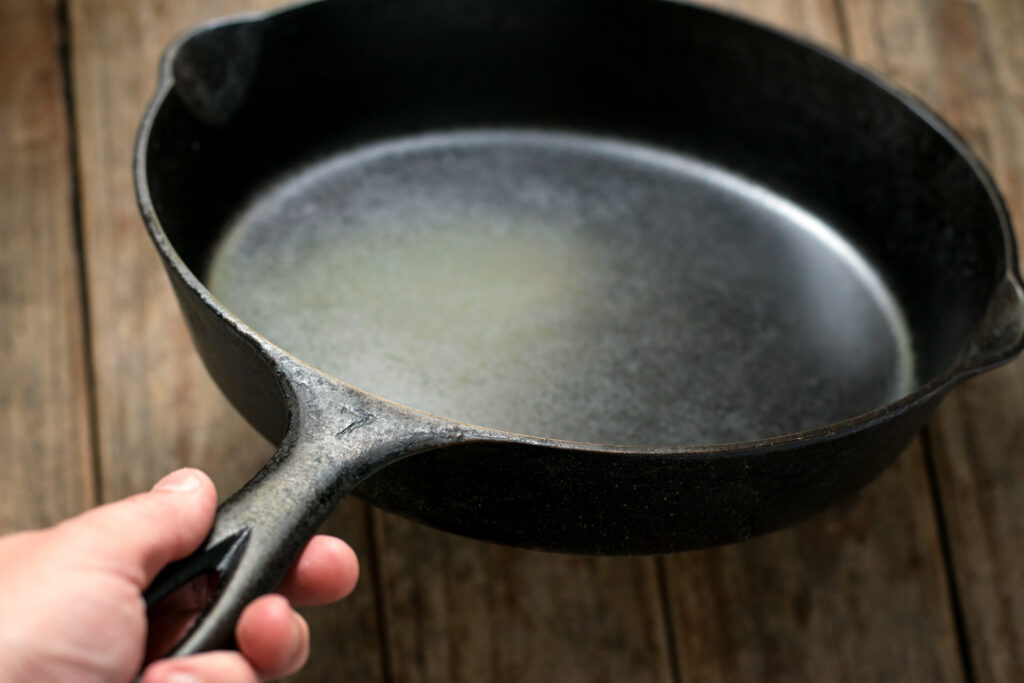
Even though cast iron is so great in many ways, it has its downfalls just like any other kind of cookware. To begin with, these suckers are HEAVY. I often say that if someone breaks into my house, my weapon of choice will be a cast iron skillet. I’m only half joking. These pans are ridiculously heavy, and they stay hot a LONG time. It can be really nerve wracking to use these when you have kids around, because the entire pan (including the handles) gets hot and stays hot (like, melt through a potholder level of hot), and dropping one of these skillets, even by accident, could easily break a toe.
If the classic seasoned cast iron skillet were a car, it would be your dad’s trusty Ford F-150 that he has had for years. It is dependable and always starts up. It can haul anything, and you can’t ever remember a time when it wasn’t around. Maybe it’s not the prettiest or the most expensive, but it always gets the job done with power and dependability.
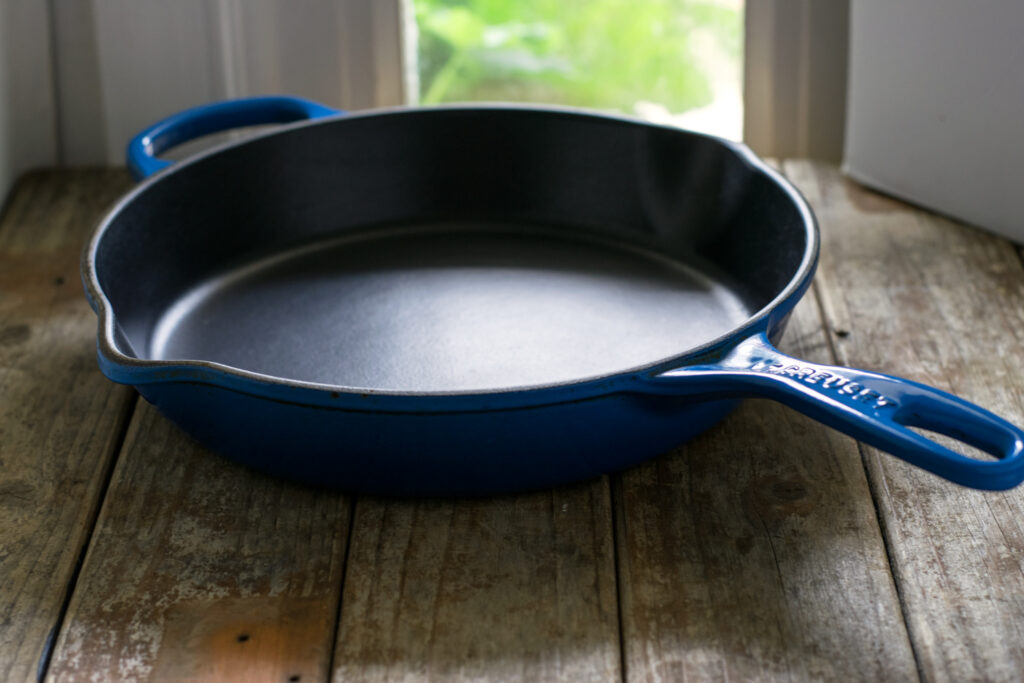
Enameled Cast Iron
Cast iron doesn’t end there, though, with the black “seasoned” skillet. There are other, more luxurious brands of cast iron which have an enameled coating on them (notably French luxury brands Le Creuset and Staub). As opposed to the roughly $20 you’d pay for a black Lodge skillet at Target, these guys will run you around $180-$250 for a skillet of the same size. Say what????? Why are these things so expensive? What does adding enamel to the surface of the cast iron do? Are these ridiculously expensive pieces worth the money?
Well, again, I can answer only according to “are these worth the money for ME.” In my opinion (yours may be different), yes, absolutely 110% yes, these are worth every penny. You don’t have to go out and buy the whole set in one day (sell a kidney, anyone?). I have collected pieces slowly over the years and now have a nice collection of about 8 Le Creuset Dutch Ovens/skillets and a couple pieces of Staub (I prefer Le Creuset). Lodge has also recently entered the enameled cast iron game, with an enameled Dutch Oven that starts at around $65 (less than a third the price of its French competitors). If you’re new to cast iron (or enameled cast iron), it’s perfectly fine to start with the lower end oven and see what you think before you invest in an upgrade. I compared Le Creuset and Lodge here, if you’re interested in what the difference in price will get you.
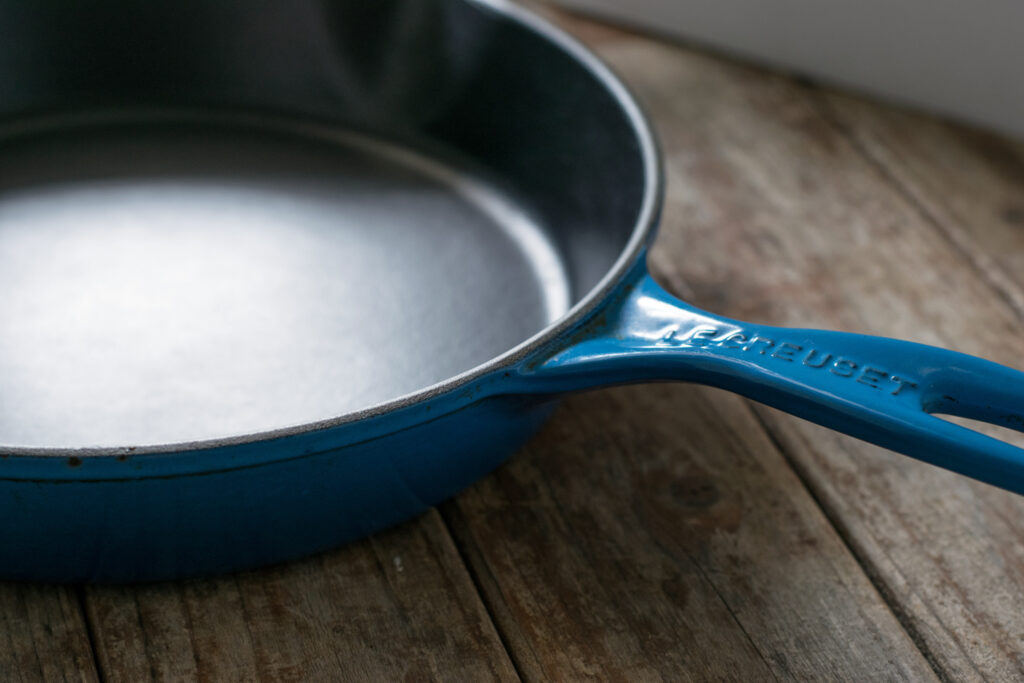
So what is the difference between regular cast iron and enameled cast iron? I could talk all day about this (and please ask questions if you have them), but the basic gist of that answer is that the cast iron bottom provides the “built Ford tough” heat capabilities of a regular cast iron pan, while the enameled surface provides the “delicate nonstick beauty” of a nonstick pan. You CAN put enameled cast iron in the dishwasher (I don’t, but you are allowed to). The pan is sealed off with the enamel finish so that no iron will rust if you do this, making it a big plus for busy cooks. The pan also does not need “seasoning,” AKA you don’t have to cook with tons of oil and rub the thing down like a prize racehorse every time you use it. You CAN use soap, and the cookware coating will remain as beautiful as the day you got it. “Big Blue,” above, is my favorite skillet. I use it almost every day for something, and I have been doing so for 5-6 years. The coating looks just as good today as the day I got it, and I can’t say that for any nonstick pan that I have ever owned. I invested in this piece after realizing that I was wearing through nonstick skillets and replacing them pretty much every year, so I figured why not bite the bullet and buy a piece that will last me forever? I’ve never looked back. It was one of the best investments I’ve ever made. It has paid for itself many times over, in my kitchen, with the way I tend to go through cookware.
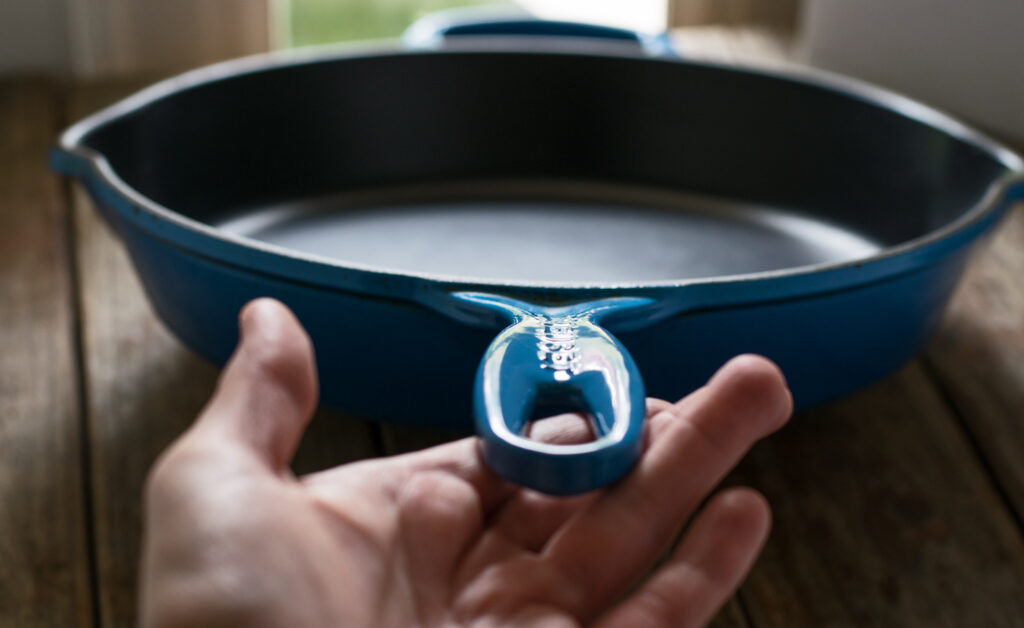
Perks of enameled cast iron: sears meat, vegetables, or anything, really, like a DREAM. It holds heat forever just like the “classic black” cast iron, but with the ease of cleanup of a nonstick pan. It’s great for frying chicken (or donuts, or oreos, or bananas, or funnel cakes, or whatever else the spirit moves you to eat) because it holds the oil at temperature. It cleans up easily with soap and water, as opposed to the paper towel “wipeout” and never being able to wash it with soap, like with the classic black cast iron. It lasts forever (guaranteed by Le Creuset, a guarantee I have personally taken advantage of– they shipped another brand new Dutch Oven, in that case, to my door, no questions asked). Gorgeous array of colors. Oven safe (so if your steak isn’t quite done on the stovetop, it goes right into the oven in the same pan to finish). You can fry, braise, slow cook, bake bread, and do everything except fly to the moon with this pan. I have done it, and I have loved every minute of it.

If you couldn’t tell, Le Creuset is probably my favorite kind of cookware, but of course I have to be honest that there are negatives to it, just like in any other cookware. Cast iron (even gorgeous enameled, bejeweled cast iron) is heavy, heavy, heavy. Luckily Le Creuset almost always offers “helper handles,” on the other side so that you can get a two handed grip on the flaming hot beast when you move it. Classic cast iron skillets don’t always have this (my Gris, above, doesn’t have it, although Lodge generally does). That helper handle is a necessity, I feel, when handling something so hot and heavy (imagine trying to lift the Thanksgiving turkey out of the oven with one hand– that’s what cast iron is like without the helper handle). The cast iron’s weight can be an issue also if you are gifting to Grandma or someone with arthritis or carpal tunnel. They won’t like this pan– it will be a pain to lift. They won’t care how beautiful it is or how nicely it sears a steak if they can’t lift it out of the sink after washing.
Another possible negative that people see (I don’t see it as a negative, but some do) is that you have to be gentle with the surface of enameled cast iron. You need to heat this baby slowly because the enamel heats up more quickly than the iron beneath it. If you turn the heat to high right away, then the enamel heats up too quickly and can explode. Say what????? Before you freak out about this, realize that turning your pan to 10 is a bad idea for any pan (even the non enameled kinds). High heat and dishwashers are actually bad for any cookware, in general, no matter what the directions say you are “allowed” to do. Be patient. Start at 3 on your dial and give the pan time to heat up. I can boil water in my Le Creuset Dutch Oven on 2 on my dial, if I give it some time for the iron to heat up. You should also use only silicone or wooden utensils (not metal) in these pans, to protect the finish. Thankfully I had learned about this before I purchased my first Le Creuset (sorry about that, Napoleon), so I have always used wooden or silicone spoons in my Le Creuset pieces.

Look at that GORGEOUS lining. The finish speaks for itself– smooth as silk. THAT is why you pay big bucks for Le Creuset– look how SMOOTH it is after all these years of cooking in this skillet almost daily. It looks just like the day I bought it. Take care of your pan, and your pan will take care of you– and that applies to any cookware.
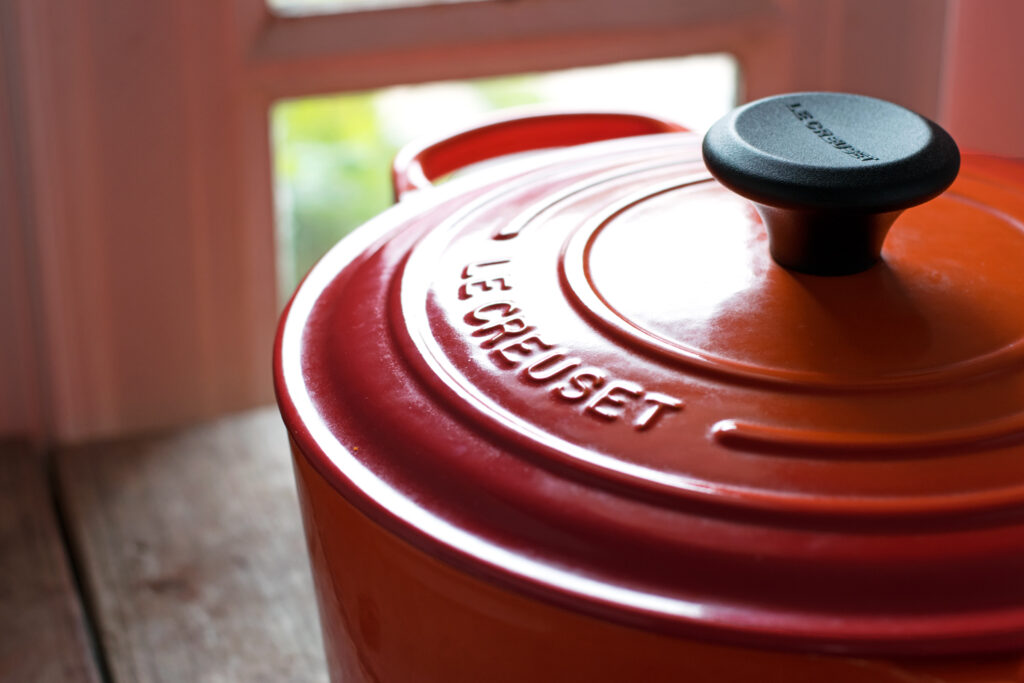
I wanted to mention also that Le Creuset (and other enameled cast iron makers) also offer a white enamel. It handles the same as the black one (and needs the same care– low and slow heat, non abrasive utensils), but I wanted to show you anyway so that you could take a look at the difference in how they look. I use this Dutch Oven (I call it OZ because it reminds me of “orange zest”) more than any other pot in my kitchen (about the same frequency as the Big Blue skillet), and it also has a gorgeous interior. White enamel is prone to slight browning and discoloration, unlike the black satin linings in the skillets, but mine has never done this because I keep the heat low and slow. I baby my Le Creuset– I can’t help it. And they look amazing to this day because I take good care of them.

Here is my assistant the lens cap showing you the inside of Oz. I have cooked hundreds of recipes with this Dutch Oven. It still looks as good as the day I got it, because I take care of it the way the manufacturer tells you to (this is why you should read the directions, males of the household).
If enameled cast iron were a car it would be the sleek, shiny Corvette that maybe you don’t *really* need, but that makes your life just oh so much more enjoyable. You put the top down and feel alive. It gets you from A to B, but somehow it also makes the trip feel like a vacation. You are happy just looking at it– just knowing it’s there, and knowing it’s yours. That is Le Creuset.
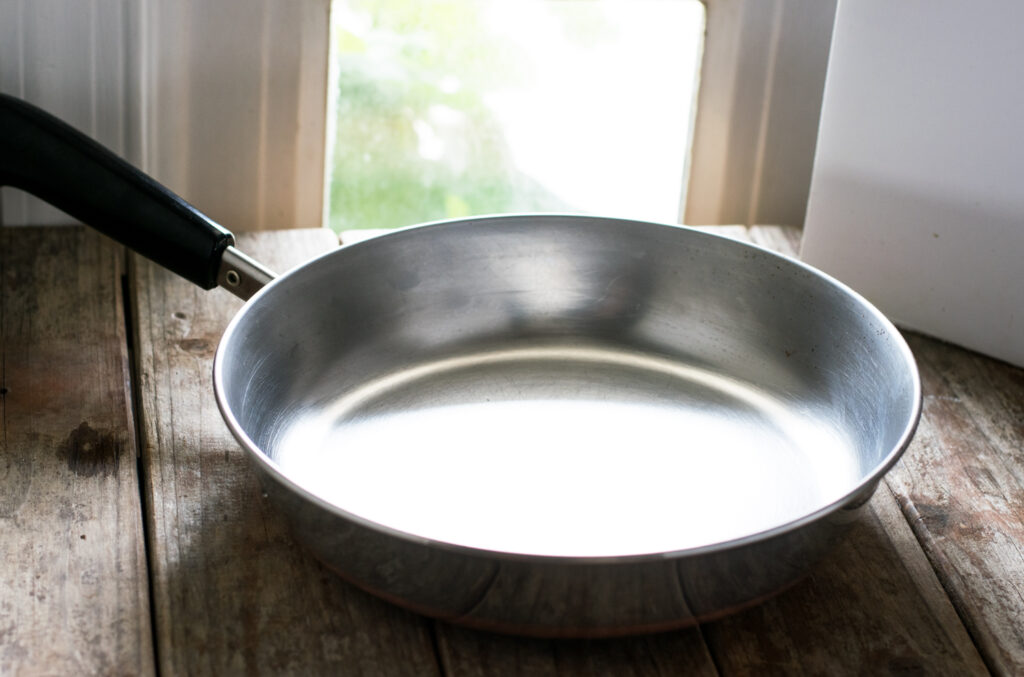
Stainless Steel
Another famous citizen of kitchens all over creation is the stainless steel skillet. Stainless steel is prized for many reasons, not the least of which is that it is basically indestructible. Commercial kitchens love it for this reason– it takes a beating and keeps on cooking its little heart out. It can sear steaks, scallops, or anything, really. A stainless steel pot can make chicken stock or spaghetti with ease. It’s a kitchen workhorse. Depending on the type of stainless steel pan that you have, it can at times also go into the oven (to finish up a steak or a chicken thigh that isn’t completely cooked on the stovetop). My vintage Revereware skillet (a gift from my friend Jacqui) has a bakelite handle, so it is not oven safe. However, steel pans which also have steel handles are generally oven safe up to 500 degrees. Steel heats up quickly and sears evenly (this copper bottom model heats even more quickly). It can at times go in the oven. It can at times go on the grill. It lasts forever. It’s a little more expensive than nonstick but not generally terribly expensive ($35 for a middle of the road skillet would be about right). It’s obvious why people like it.
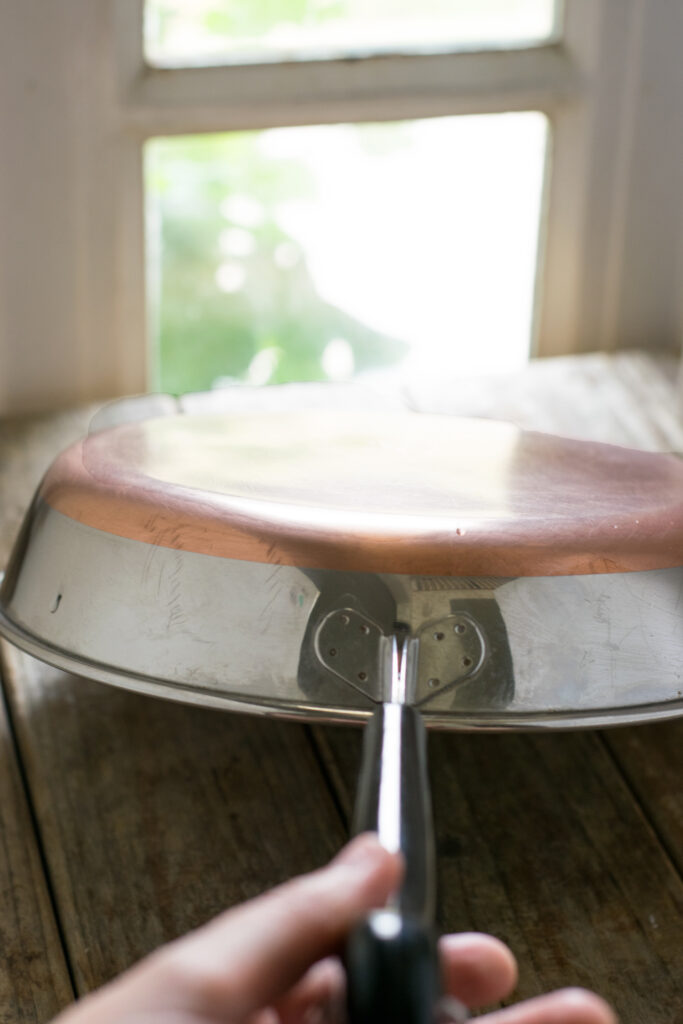
So why doesn’t EVERYONE use it, if it’s so great? There you go, being negative again. Well . . . let’s not call it negativity. Let’s call it honesty. Every single type of cookware has both good and bad things about it, and only you can decide what functions or features are necessities or dealbreakers for you. Stainless steel’s greatest flaw is that it sticks to food like nobody’s business. Yes, sadly, this guy is the type who calls 25 times after a date to ask why you haven’t called him back yet. He’s a stage 4 clinger. To EVERYTHING. In the cookware world the other pots and pans would take out a restraining order on him, because he CAN’T. EVER. LET. ANYTHING. GO.
Professional chefs get around this by using lots of oil when cooking– they aren’t eating everything they create, so they don’t have to worry about using a lot of oil in dishes like the home cook does. But a home cook doesn’t want to drown the dish in oil each time she cooks, if she wants to live to see 65. Stainless steel pans also have the decidedly unpleasant habit of forming “scorch spots.” If a pan scorches somewhere, then it will burn in that same spot forevermore, every time you use it from now to eternity. The pan basically has to be thrown out at that point. Of course, like most pans, you can avoid the scorching by keeping your heat lower. Unlike the others you CAN use metal utensils in stainless steel pans, and they are dishwasher safe (although they can develop weird water spots which don’t affect the cooking but make them look like an acne-clad junior high student) if you have hard water at your house.
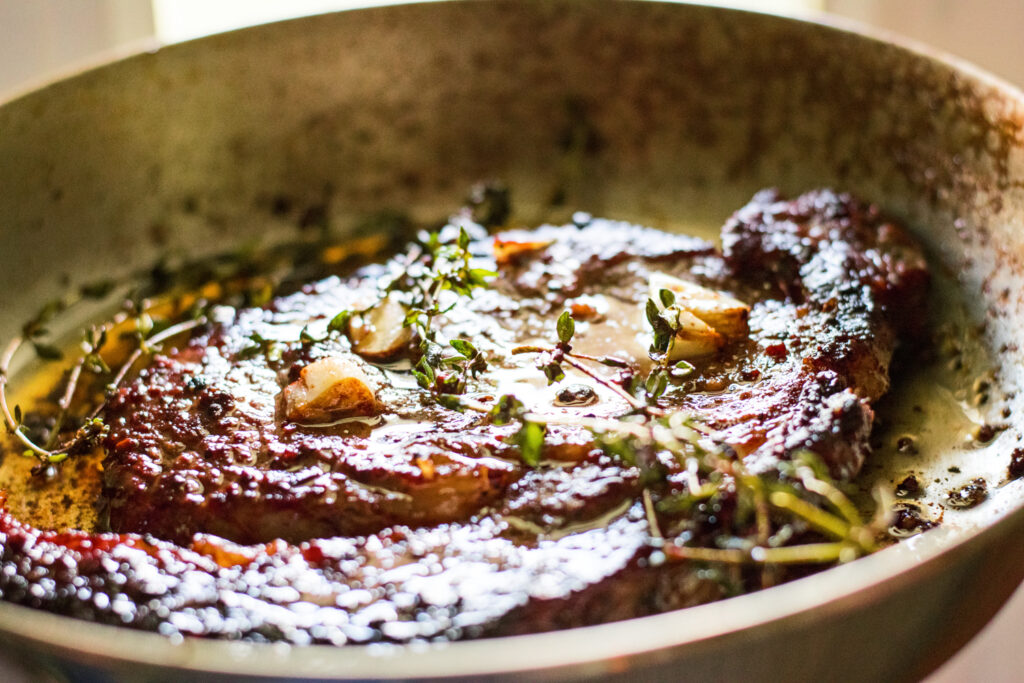
I personally feel that everyone should give the classic stainless steel pan a try, to see what you think. Yes, you can get along without it (and I did, for many years). But they really are great if you need a lightweight workhorse that can take to higher heat than a nonstick and that you need to heat up more quickly than a cast iron pan.
This pan is a Subaru Outback. It is a medium price point, it has some nice features and some weird quid pro quos, but lots of people just hang out with it and get it every time, no matter what else is out there. They are used to it. It has a loyal following; it lasts a long time. It is a safe (though not necessarily luxurious) choice. It will get you out of the snow every time and last forever, and isn’t that why we all love Subaru and stainless steel?
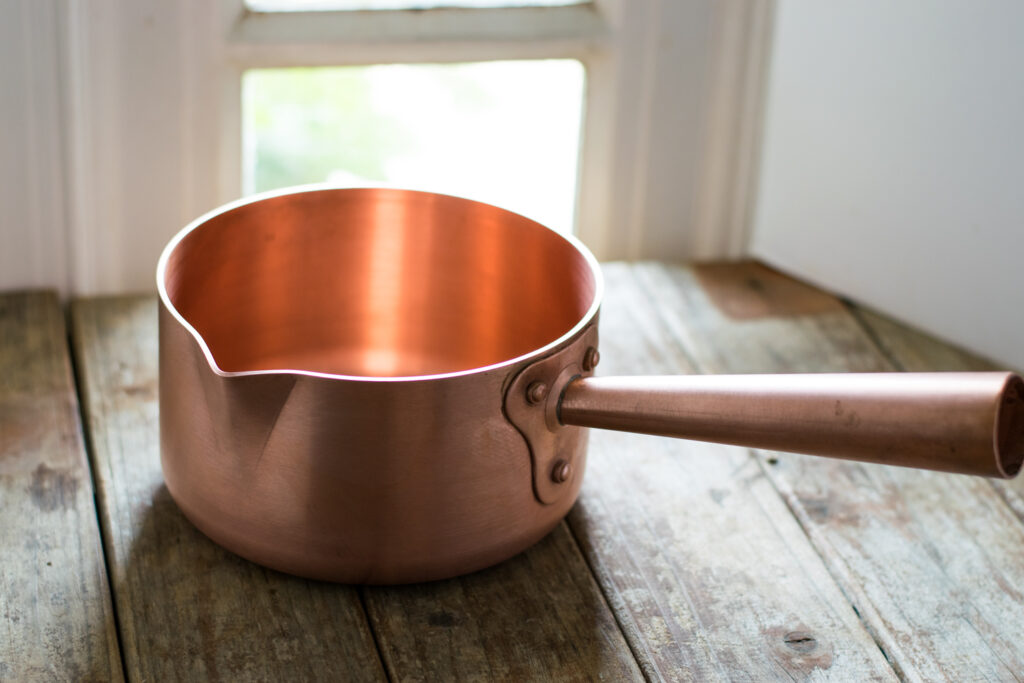
Copper
Ahhhhhh. Here we have an extremely specialized item, but I wanted to mention it specifically because under this umbrella I will place “all expensive, specialty cookware that is used by a very select few, whose needs are so specific that they don’t flinch when paying prices which stop the blood from flowing to one’s brain as the blood cells scream and abandon ship.” Something along those lines.
Copper has become extremely in vogue of late, mostly due to its beautiful color. When the movie Julie and Julia came out, reams of people went out and purchased Julia Child’s Mastering the Art of French Cooking, then let the unwieldy volume languish, untouched, for another 20 years on the shelf because HOLY COW THESE RECIPES ARE COMPLICATED AND TAKE ALL FREAKING DAY!!!!! People often buy things because “some expert” recommends them, rather than because they have actually taken the time to think about what they genuinely need or will use. Did you ever notice that every finished kitchen on HGTV has a Le Creuset Dutch oven (in gorgeous, matching color to the kitchen tiles!) sitting on the $40K Viking range? Ah, yes, my friends. All the people on that show want a high end kitchen, presumably so that they can heat up their hot pockets in their high end microwaves. I exaggerate, but the principal is true. Cookware does not magically become better simply because it is expensive. Someone who doesn’t know how to cook won’t magically become a fabulous cook, just because he or she has the best or most expensive kitchen equipment out there. That’s not the way it works.
I have seen people burn the heck out of gorgeous, expensive Le Creuset cookware. They ruined the crème de la crème of cookware because they didn’t know what they were doing. Putting expensive, specialized cooking equipment into the hands of an amateur is like putting a snowplow on a Ferrari– a Ferrari is not meant for that, and if a Ferrari failed at that task it is not the fault of the machine, but of the user, who has no clue how to use the equipment the way it was designed. Generally, expensive cookware is expensive because it is highly specialized and well made. You are paying for that specialty. You are paying for that quality. But these high end pieces are still tools, waiting to be brought to life by your hands. They won’t magically make you a better cook. Don’t buy something if you don’t need it or don’t know how to use it. It’s a waste of money.
That being said, there are occasions when someone DOES actually need a specialty item, and in that case, it’s best to pick and choose individual pieces in an expensive, specialty category, rather than getting a whole set. The above copper pot is the most specialized one in my collection, purchased after research which took me many years, for a very specific purpose.
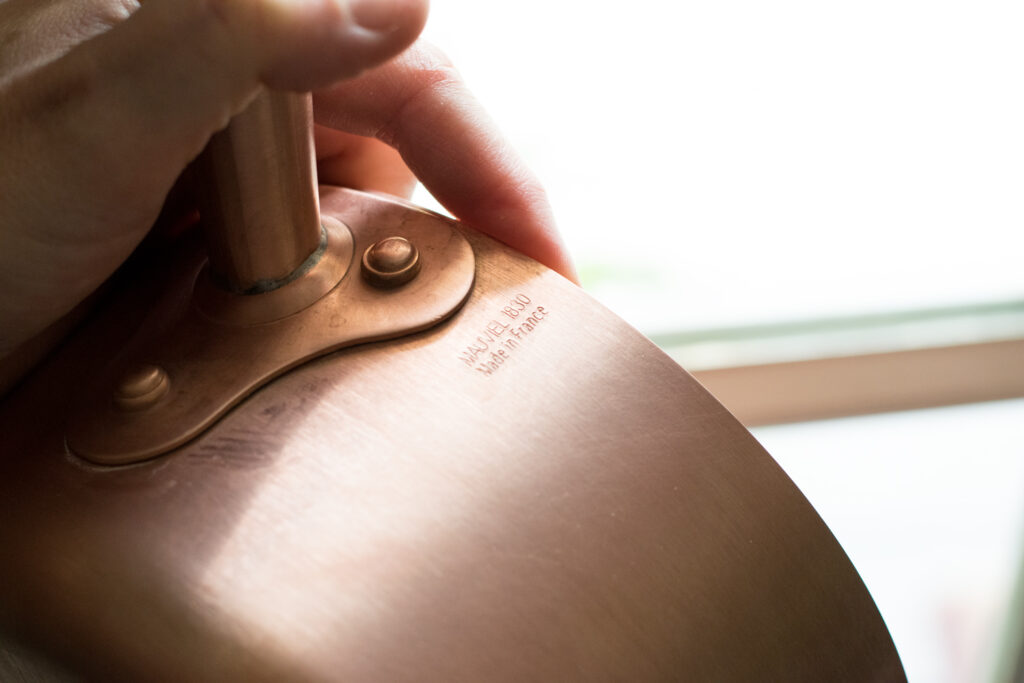
This is a a pure copper, French made, Mauviel sugar pot. Copper is prized on pans, not only for its beautiful color, but also for its incredible heat transfering ability. Copper is used in electrical wires for the same reason– it is an excellent conductor. A copper pot heats up instantly, and then cools down instantly when removed from the heat source. This makes it a superb sugar pot– when even a few degrees of cooking difference can change your soft caramel to a hard, breakable hard candy. Each degree matters in sugar work, and you must measure your temperature to the exact degree to get your recipes right. The sugar pot is a necessity for anyone who makes a lot of fancy pastries or deals with spun sugar or candymaking of any kind. Melted sugar is molten hot and will melt the nonstick lining right out of a nonstick pan. A cast iron pan will heat it up but continue to hold the heat even after sugar has reached that critical temperature, overcooking and ruining it. Not to mention, you don’t want to be hefting a heavy iron pan with basically boiling lava inside.
Enter copper. Its deftness with heat makes it a true racecar– built for one thing– speed. You don’t need lights in a racecar. You don’t need windshield wipers. You don’t need anything but ENGINE. Copper is like that specialty racecar– built for one purpose, which it does flawlessly well.
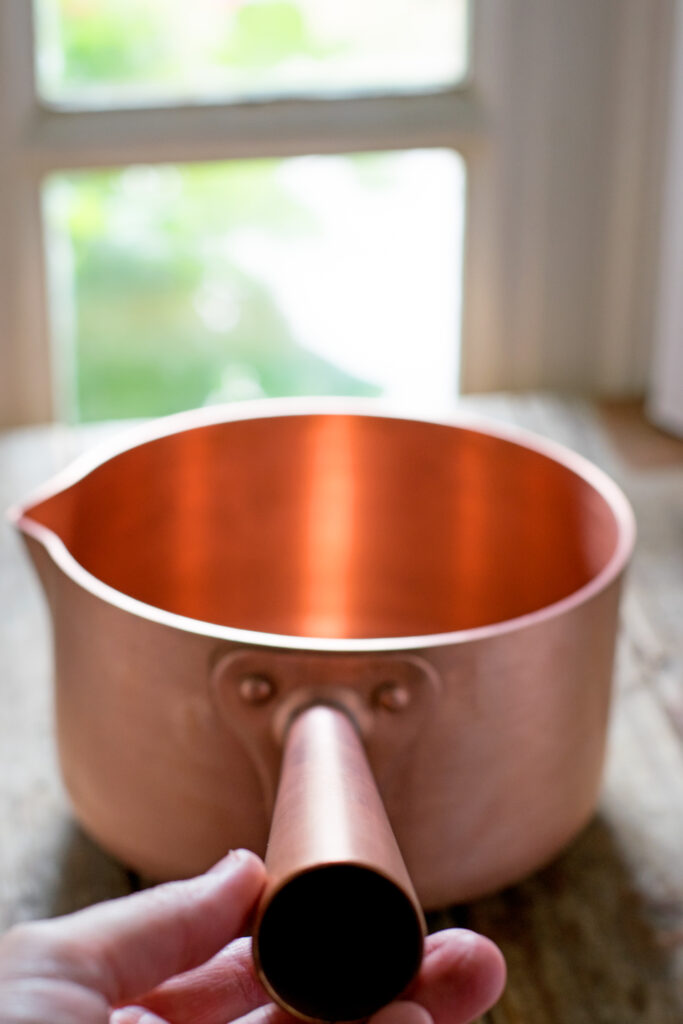
That being said, know that, yes, this racecar is good at that one thing, but it is good at ONLY that one thing. You don’t take a racecar for a drive at night, because it has no headlights. You don’t take a racecar to get groceries– there is no cargo storage area. A racecar is good for one thing, and one thing only– racing. Copper cookware is good for one thing, and one thing only– getting hot very fast, and cooling down very fast.
Cooking almost anything except sugar in a copper pan will result in a weird, metallic taste. Copper also tarnishes almost instantly after using. This means that to keep your piece looking nice, you will need to wax, polish, and buff it every single time that it is used (and it will start oxidizing again almost immediately). Most pans that use copper have a copper bottom to take advantage of the heat, but they include a lining made out of something else on top (like stainless steel) to keep the food from touching (and tasting like) the copper. Sugar does not absorb the taste of copper, but other foods (especially acidic ones), definitely do. For this reason, almost all copper cookware is lined with something else (tin, aluminum, stainless steel, and even pure silver in the shatteringly expensive Duparquet line). Sugar is the one special ingredient that will not react with copper, which means that sugar pots do not need a lining. This pot is for sugarwork and absolutely nothing else. Most kitchens would never have a need for this, but mine does.
Pure copper pots are truly a thing of beauty– heating so quickly and with such evenness that it almost defies description. Watching a copper pot in action is like watching an experienced couple waltz in perfect harmony. The dance that copper does with sugar is a thing of beauty. But don’t try to make your morning oatmeal with it– you will regret it on the first bite. Yuck.
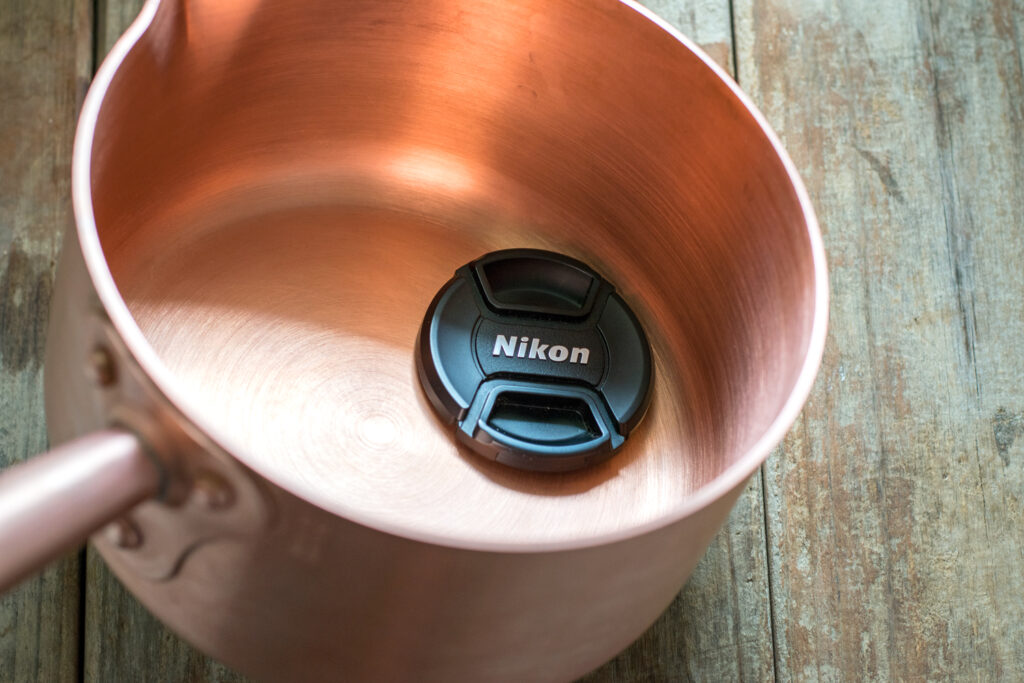
But then again, this baby isn’t made for making oatmeal. It is meant for racing sugar down the finish line to beautiful, caramelized bliss. It is perfectly crafted for that purpose. You give up pretty much every other feature, just to have this speed feature so finely tuned. For candymakers, macaron makers, and sugar workers, the payoff is definitely worth it.
So after all that, my beloved ones, what have we learned?
At the end of the day, the best cookware for you is the cookware that helps YOU the most. It doesn’t matter what this cookware costs, what expert recommends (or loathes) it, or what fancy name is on the lid. What matters is whether you feel confident using this piece of equipment. Are you afraid of using something because it is too heavy or expensive? Then don’t get it. You won’t enjoy cooking with a tool that makes you uneasy or uncomfortable.
When I buy something new, I first read a lot and borrow it from a friend to try out, first, if I can. I find out what kind of people “like” this cookware– are they pastry chefs? Home cooks? Beginners? Why do they like it? What don’t they like? What problems do they have with it, and would I find those things to be an issue or not? If possible I got to the store and handle a piece of it– to see how it feels in my hands. When something feels solid and good in my hands, then I know it will do a good job for me. Your hands know what they are doing. Give them a little bit of credit and take their word for it. They’re doing all the work, anyway. If something feels unstable or weird to my hands, then I don’t get it– no matter what fancy name is on the lid or how many people tout it as “the best thing out there.” The experts aren’t in my kitchen– I am. So their opinion doesn’t matter to me like my own experiences do.

Experimentation is half the fun. Your cookware doesn’t have to be what others “recommend.” It doesn’t have to match. It doesn’t have to be expensive or what you grew up using. It just has to perform well for YOU– and make you happy. And if your chili tastes good, then that’s good enough for me, no matter what you used to create it.
You did it. And I’m just so proud of you.

Disclosure: This post may contain affiliate links, which just means that we get a few pennies if you purchase through our link. I never recommend products that I don't personally use and love. Thanks!
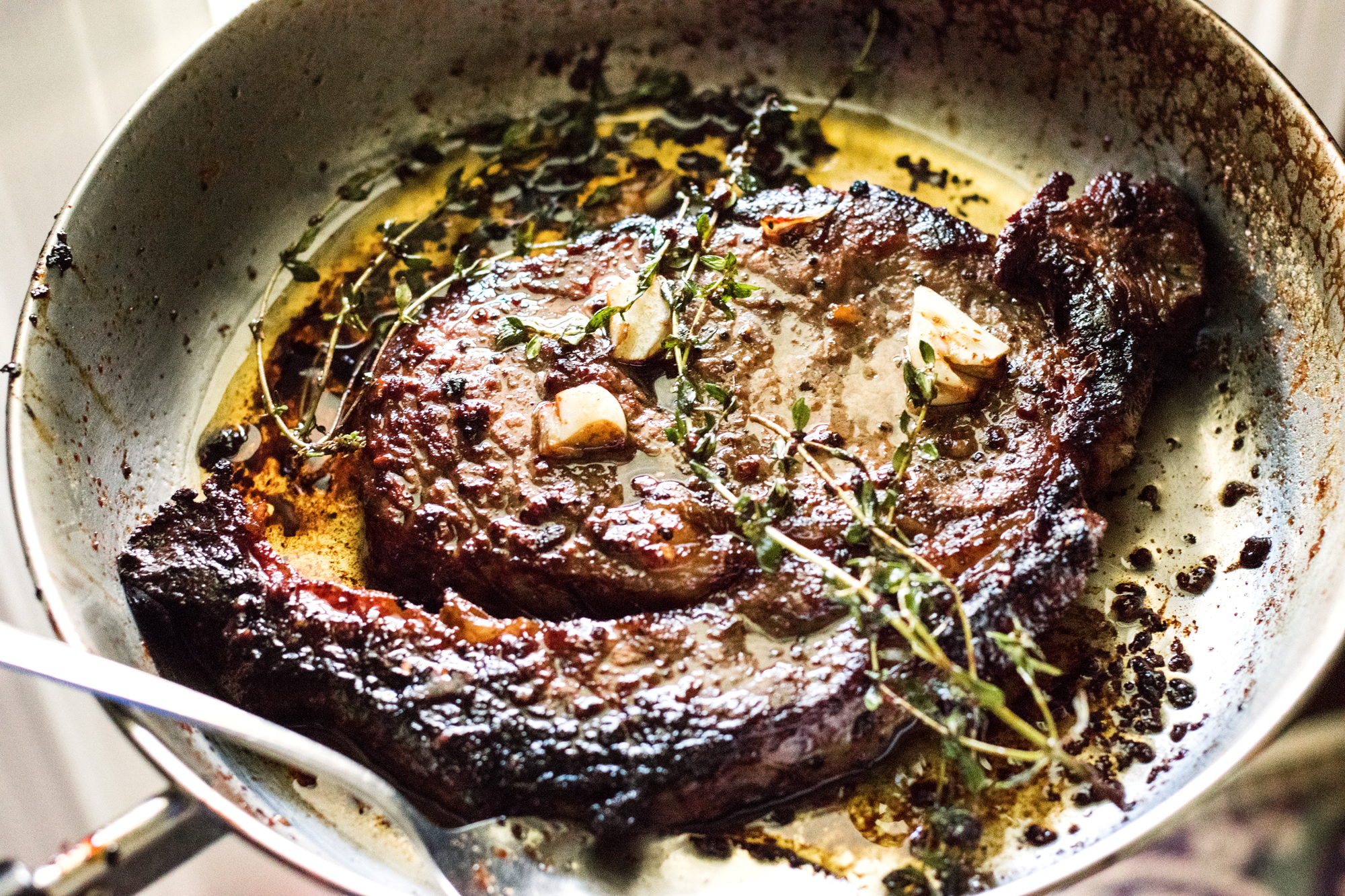
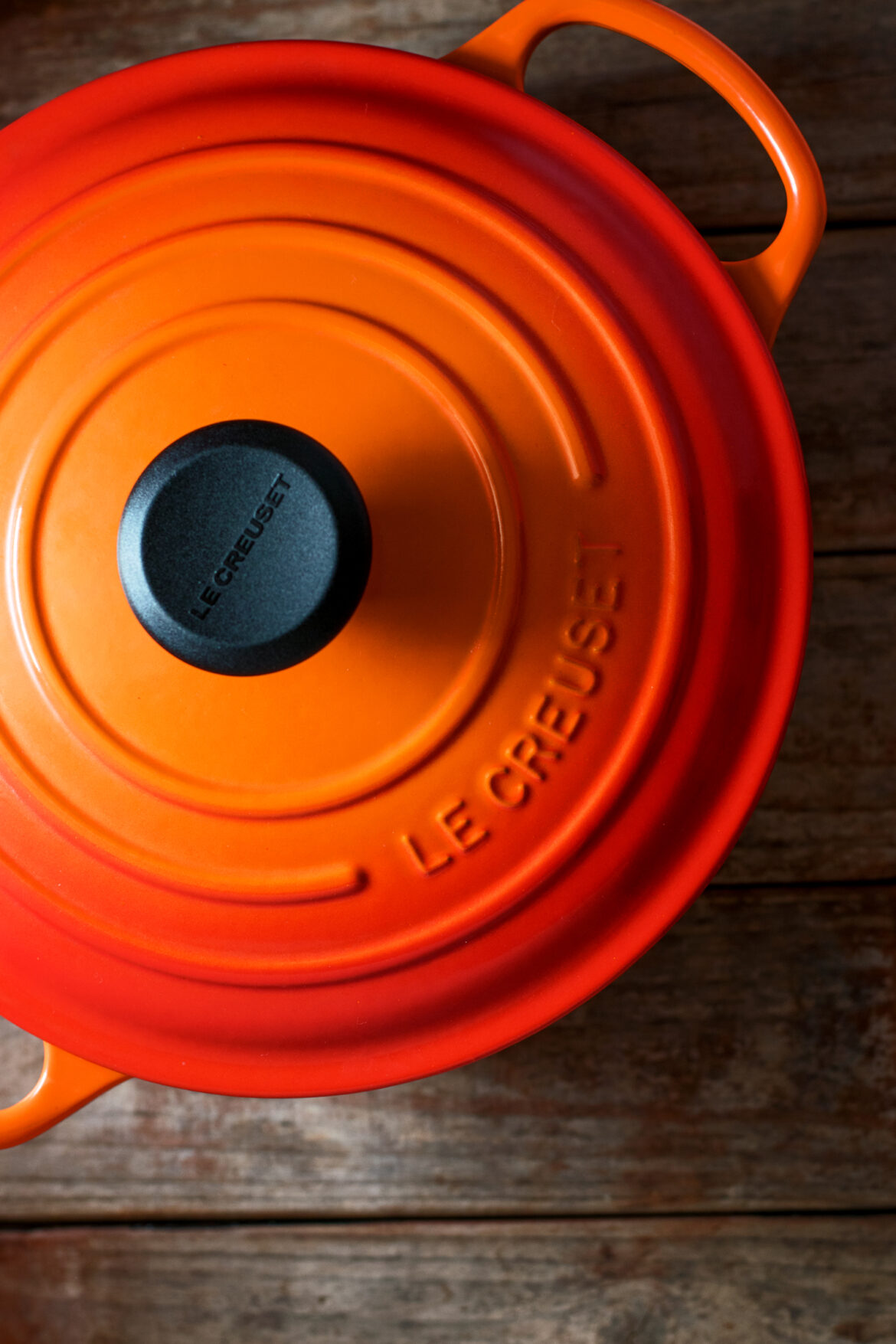
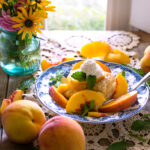



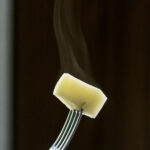

Emilie, this is THE most informative article on the different aspects of cookware I’ve ever seen. EVERY cook should see it and that’s why I want to share it. I have learned so much today I did not know. Thank you for taking time to put your knowledge, in such a delightful way, out there.
I’m no expert but sometimes the choices are so daunting. It’s nice to have some easy explanations of what easy type does and doesn’t do well. You are an amazing cook so I’m sure you could add lots of info to this! Thank you for taking time to read <3